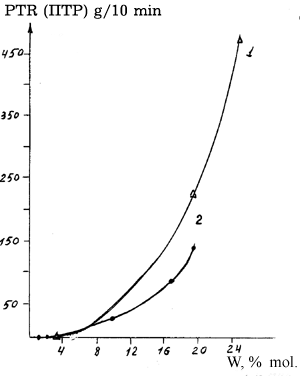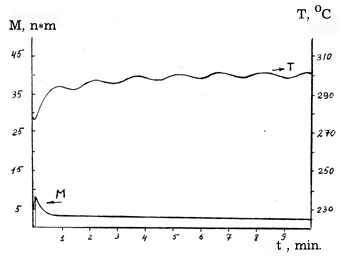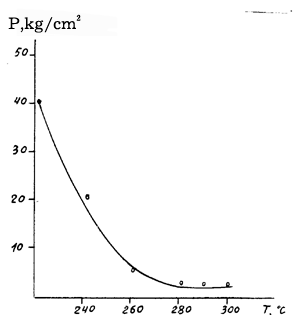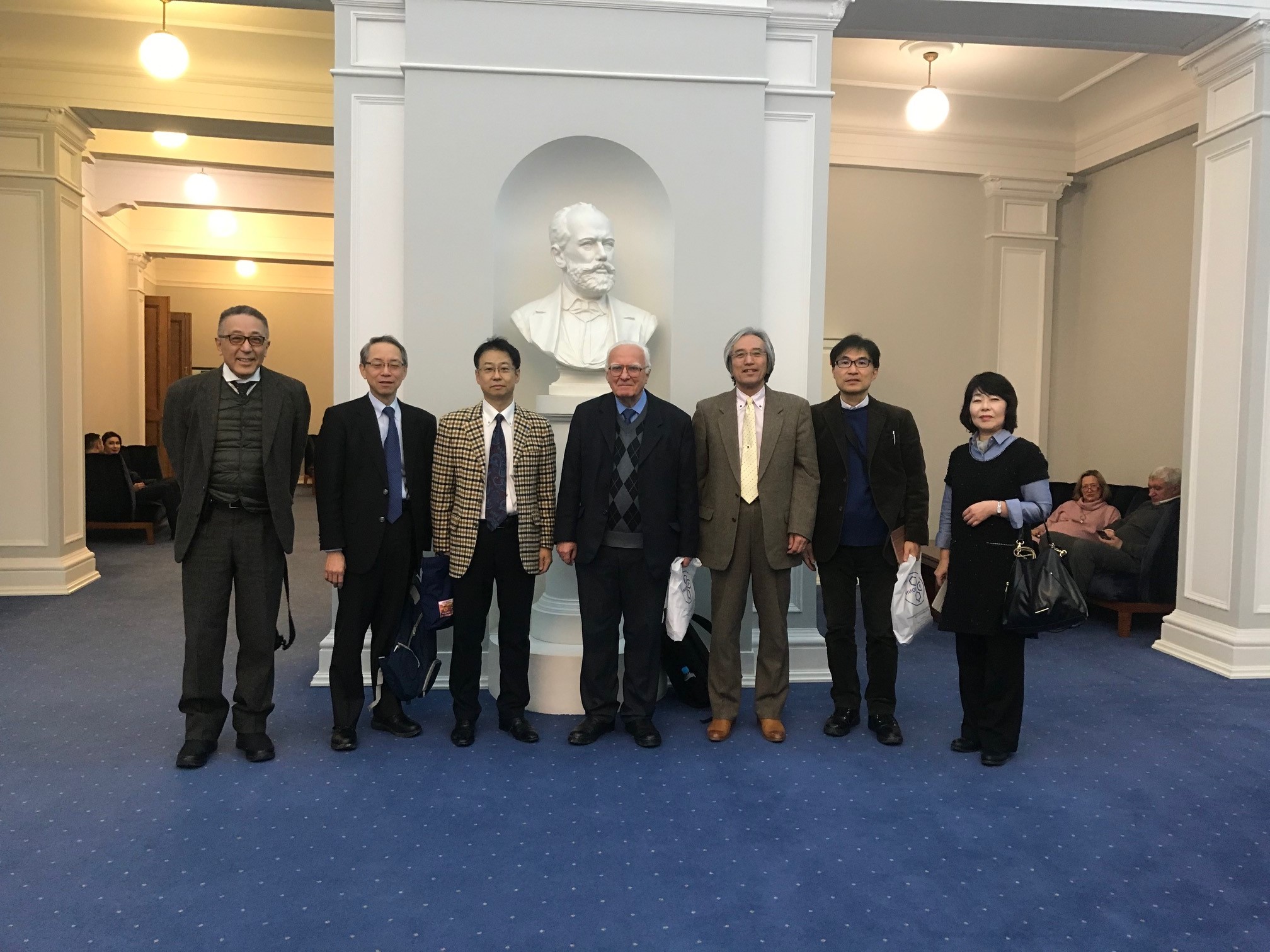Fluorine Notes, 2000, 9, 5-6
Synthesis and application of ![]() -bromo-perfluoroalkylvinyl ethers.
-bromo-perfluoroalkylvinyl ethers.
P.M.Chekmarev, A.A.Poliakova, V.M.Andrushin
Report VI. Study of some conditions of processing copolymers of fluoroolefins with ![]() -bromo-perfluoroalkyl ethers.
-bromo-perfluoroalkyl ethers.
Introduction
During the investigation of the conditions of copolymerization of tetrafluoroethylene (TFE) and
vinylidene fluoride (VDF) with ![]() -bromo-perfluoroalkylvinyl
ethers (BrAVE) and also during the study of their physical and mechanical properties, a significant
heterogeneity of their properties in comparison with other fluoropolymers based on TFE and VDF has
been found. Considerable data scattering of the properties of different lots of the copolymers produced
under identical conditions and having close molecular mass and ratio of TFE (VDF):BrAVE was observed
.
-bromo-perfluoroalkylvinyl
ethers (BrAVE) and also during the study of their physical and mechanical properties, a significant
heterogeneity of their properties in comparison with other fluoropolymers based on TFE and VDF has
been found. Considerable data scattering of the properties of different lots of the copolymers produced
under identical conditions and having close molecular mass and ratio of TFE (VDF):BrAVE was observed
.
Therefore, some investigations on determination of the process conditions for processing copolymers
to stabilize the properties of articles made from them were carried out.
Determination of flow and fusibility of the copolymers of BrAVE
with TFE and VDF.
The melt flow index was taken as the main characteristic of the new fluoropolymers. It was determined
on a capillary plastometer IIRT-M according to State Standard 11645-13. The load was 2.16 kg, draw
plate diameter of 2.093mm, 270oC.
The data of fluidity of copolymers of TFE with BrAVE
are given in Fig.1 ( Curve 1: BrAVE-2; curve 2: BrAVE-4)

Fig.1. Dependence of the melt flow index of copolymers of TFE with BrAVE
on the BrAVE monomer content (W, mol%) and its chain length.
As it is seen from Fig.1, flow of the melts of copolymers of TFE with BrAVE is slightly decreasing
with the growth of the chain length in the alkyl fragment of the BrAVE monomer and sharply increasing
with the increase of the BrAVE content in the copolymer; the flow increase is observed from the BrAVE
content of approximately 3mol %.
As it should be expected, the behavior of TFE copolymers with
divinyl ethers produced from BrAVE monomers according to the scheme described in report IV is absolutely
different.
The introduction of less 0.1mol% of diene into the chain of TFE copolymer with perfluorobutylvinyl
ether (DVE-4) almost does not affect the copolymer properties; when the quantity is increased to
0.2-0.3%, the melt flow index is reduced approximately twice. A further heat processing of the polymer
does not change the melt flow index. The introduction of 0.5-1 mol% of DVE-4 to the chain results
in a polymer with a very low melt flow index (0.1-0.5g/10min) and its pressure molding into film
leads to an additional cross-linking with complete flow loss.
Copolymers of DVE-4 with VDF containing
1-1.3mol.% of diene are high-melting soluble products difficult to process into a film but after
heat treatment (200-250oC) during pressing they lose their flow and solubility that is
confirmed by the data of IR-, F NMR-spectroscopy.
Homogenization of BrAVE copolymers with fluoroolefins.
Both in determination of physical and mechanical properties of BrAVE copolymers with TFE and VDF, and
in determination of the melt flow indices , considerable discrepancies in data on copolymers of identical
compositions have been noted. Therefore homogenization of the polymer by additional stirring of its
melt was used as a processing route to stabilize characteristics of films and other articles made
from newl fluoropolymers. The homogenization was carried out on a laboratory rheological measuring
device, “Plasticorder PLD-331” of “Brabender”(Germany) made with the use of a mixer of W 50H type.
The duration of mixing was 10 minutes at a temperature of 277-300oC and at a speed of
rotation of operating elements of the mixer of 70 rpm.
The homogenization process was controlled by values of the torque on the drive axis of the mixer
M, nm, and by the temperature of copolymer melt T,oC, in the mixer chamber. These data
as dependencies M=f(t) and T=f(t), where t, min, is the time from the moment of sample loading into
the mixer, are given in Fig.2 for the copolymer sample containing 3 mol.% of BrAVE ( MFI=1.45 g/10min
at 270oC and elevated load P=10kg).

Fig.2 Dependence of torque M,nm, and melt temperature T,oC,
on the homogenization time
It is seen that at the moment of loading a powder sample, the M value is the maximal and further
it is decreasing with the copolymer melting. During the subsequent homogenization the M value is
monotonously reducing with increase in t value that may be explained by processes of thermal and
mechanical destruction of the sample. But the value of this reduction during 10 minutes of the homogenization
( that corresponds to the real residence time for the copolymer melt in the processing equipment)
is small.
As another example, a copolymer sample containing 4.5 mol% of BrAVE had melt flow index
of 0.16g/10min prior to homogenization. After the homogenization, the value of melt flow index increased
to 43.6 g/10min. Redefinition of the melt flow index for the same sample gave the value of 58g/10min,
later on the value of melt flow index remained the same.
The given data are the evidence of the
good result of the homogenization of BrAVE copolymers with fluoromonomers, namely: the flow index
of the copolymer is stabilized that allows to process it with conventional methods and multiple granulation
does not worsen the melt properties but also is necessary before processing into articles.
Development of regimes of compression pressing of BrAVE copolymers
with TFE and VDF.
As it was noted, the modification of polytetrafluoroethylene by perfluoromonomers with functional groups
gives fluidity and availability for its processing by conventional for plastics methods .
Development
of regimes of compression pressing films from the copolymers produced was carried out on a K-18 press
(Poland). The sizes of films manufactured were (0.17-0.025) mm at the following parameters: load
mass of 6g, electrical heating power of 2800W, mold mass of 13.7 kg.
Copolymers containing 1.3-19.5mole
% of bromine-containing polymer were studied. The pressing conditions varied within a wide range:
temperature of 220-350oC, specific pressure of 5-140 kgf/cm. The quality of films was
evaluated visually ( transparency, absence of bubbles, of foreign inclusions and gels), according
to polythickness (a Micrometer) and brittleness ( a NG-1 instrument). Satisfactory quality of the
films was attained using copolymers of TFE with 3-19.5% (mole) of bromoperfluoroethylvinyl ether.
When the BrAVE content is reduced to 1.3 mol % at a pressing temperature of 310oC and
pressure of 12 kgf/cm, a brittle film is formed obviously due to insufficient material melting. Only
at a temperature of 340-350oC and pressure of 80-100kgf/cm some increase in elasticity
and transparency of the films is observed.
The optimal regimes of pressing films of TFE copolymer
with 10% (mole) BrAVE are given in Fig.3 as pressure versus temperature providing fabricating high-quality
films. Average rates of heating and cooling the mold were 6 and 7.5 oC/s respectively.

Fig.3 Optimal conditions ( pressure, P,kgf/cm and temperature, T,C) for pressing
films from the copolymer of TFE and BrAVE (10mole %)
Conclusions
The influence on the fluidity of melts of copolymers of TFE and VDF with BrAVE of the content and chain length of BrAVE monomer in the fluoroalkyl fragment of the copolymer molecule has been studied.
It has been found that the fluoropolymers produced can be processed by conventional methods and the method to stabilize the properties of the copolymers by homogenization has been developed.
The optimal regimes of compression pressing of the films from the copolymers produced has been developed.
Fluorine Notes, 2000, 9, 5-6
